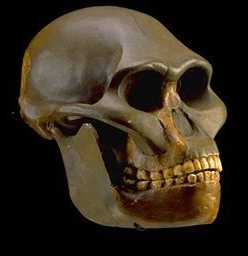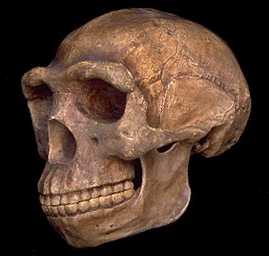Human Evolution
Dr. C. George Boeree
Human Evolution
Dr. C. George Boeree
The basics of evolution are quite simple. First, all animals tend to over-reproduce, some having literally thousands of offspring in a lifetime. Yet populations of animals tend to remain quite stable over the generations. Obviously, some of these offspring aren't making it!
Second, There is quite a bit of variation within any species. Much of the variety is genetically based and passed on from one generation to another. Included in that variety are traits that help some individuals to survive and reproduce, and other traits that hinder them.
Put the two ideas together, and you have natural selection:
Nature
encourages the propagation of the positive traits and discourages the
negative
ones. As long as variety continues to be created by sexual
recombination
and mutation, and the resources for life remain limited, evolution will
continue.
Like any other creature, human beings evolved from earlier forms,
and there are plenty of fossils of intermediate types to show the
progression. More than five million years ago there lived
the common
ancestor
to humans and apes -- a dog-sized primate (already distinct from the
ancestors of monkeys) who wandered the African
grasslands
but never strayed too far from the safety of the trees. This is
an important point: We are not "descended from apes!" We
and apes were descended from common ancestors. Chimps and
gorillas and orangs and humans all underwent millions of years of
change to become who we are today.
 Approximately three million
years ago, a branch of these primates
evolved into Australopithecus (see image at left).
Australopithecus was between
4 and 5 feet tall, clearly walked on two legs, was a tool user (chipped
stones), and apparently hunted. Australopithecus had a brain
about
400 to 500 cc, about the same as chimps and gorillas. The most
significant
find of Australopithecus remains became well known as "Lucy."
Approximately three million
years ago, a branch of these primates
evolved into Australopithecus (see image at left).
Australopithecus was between
4 and 5 feet tall, clearly walked on two legs, was a tool user (chipped
stones), and apparently hunted. Australopithecus had a brain
about
400 to 500 cc, about the same as chimps and gorillas. The most
significant
find of Australopithecus remains became well known as "Lucy."
Around two million years ago some Australopithecus evolved
into
A. (for Australopithecus) boisei and A. robustus.
Not ancestral to us, they were quite powerful and
had large jaws and a ridge along the top of the skull to which were
attached
powerful jaw muscles. For all their strength, they became extinct
long ago.
Also about two million years ago, another branch of
Australopithecus
became our ancestor, Homo habilis, which means "handy
man."
An early tool user, H. (for Homo) habilis stood about 5 feet tall,
weighed
about 100 lbs, and had a brain from 500 to 800 cc..

About one million years ago came a closer ancestor of ours,
H. erectus (image to the right), the first fire user and the
first to leave Africa.
Erectus had a larger brain -- about 900 to 1200 cc. They may be
more
familiar as "Java man," "Peking man," and so on, named after where
their
remains were discovered.
About 300,000 years ago -- H. sapiens enters the scene, back in Africa, with a 1200 cc brain. Archaic H. sapiens probably had speech, tools, and buried their dead.
150,000 to 30,000 years ago came H. neanderthalensis, as some prefer. A cousin of ours, not an ancestor, they were about 5 ft 6 in tall, with heavy bones and large brows. They had a brain that was actually a bit larger than ours - 1350 cc. Their remains are found primarily in the Near East and Europe.
At about the same time as the Neanderthal came Homo sapiens
- us - with a brain about 1250 cc. We seem to have invented art
in the form of cave paintings and female statuettes. We probably
began in Africa, but spread rather quickly into the Near East and
Europe.
It is possible that we were in part responsible for the demise of the
Neanderthals.
By 60,000 years ago, we were well in place in all of Asia, and by
30,000
years ago, we had even entered Australia and the Americas.
Many people mistakingly believe that the different "races" of the world are like
different sub-species. They are not. Although we sometimes
look quite different from each other, the actual genetic differences
are extremely small. Besides which, except in unusual situations
where there has been dramatic population movement of separated genetic
"pools" - such as the migration of Europeans and the forced migration
of Africans to the Americas - there are no lines that differentiate
one "race" from another. They slowly blend into each other over
distances. "Pure" races are myths, and the idea of race itself
isn't that useful.
(For more on race, click here!)
Ultimately, all human beings are related to each other, very
literally. And we are probably related to every other animal,
plant, and micro-organism on this planet as well! Get used to it.
So what's so great about the genus Homo? How did we manage to survive with our little teeth and useless fingernails, and not even much fur to protect us from the sun and the cold?
First, being upright may have been a plus. It allows one to see over tall grass and to keep one's head above water when wading in rivers and lakes. It allows for a somewhat faster land speed than our primate relations (although much slower than four-legged creatures who liked to dine on our ancestors). And being upright leaves our hands free to carry things such as food and tools and to throw rocks at enemies.
Which leads right into our second plus: We have great hands that let us hold and manipulate things well. It would have been difficult to start making tools without that opposable thumb!
Third, we were excellent vocalizers, with great vocal cords, mouth, tongue and lip movement, and awesome breath control. Lots of potential for communication!
And last, but not least, we had a large brain to begin with. Being relatively weak, we were able to think fast on our feet, and those that could think faster lived longest and left the most descendents - and so the brain continued to develop. In addition, there was plenty of room for language to develop as a special adaptation of all that vocalization.
There are other things about us that are curious. For example,
why are we so relatively hairless with such plentiful layers of
fat under our skin? One theory is that at least some of our
ancestors spent an inordinate
amount
of time in the water, and we were on our way to evolving in the general
direction
of other water dwellers. There are many other traits that support
the idea, such as our downward-pointing nostrils, the amount of fat on
our newborns, the way we can hold our breath (something that also helps
with vocalization), and even the curious habit of weeping!
It is also likely that we began using fur and plant coverings -- clothing -- relatively early. Ancestors with less hair may have had a small but significant advantage in such a case, since they may have had fewer problems with disease-carrying insects living between skin and clothes, and would be able to cool off and dry off more easily depending on conditions.
Another oddity about human beings is our rather strong sexuality. In this regard, we are similar to one our nearest relatives, the bonobo chimps, who are even "sexier" than we are! They apparently use highly promiscuous sexual contact, even between close relatives, to support social bonds in the group. In human beings, the strong sexual interest that women have (as opposed to the females in many other species) may have developed as a way of keeping the father of a woman's babies around as a helper.
What's next for Homo sapiens? It seems unlikely that we will
be
doing too much dramatic evolving, because we are no longer hidden away
in
isolated ecological niches where mutations have a chance to make their
play for survival. Instead, we should move into a phase where we
become increasing homogeneous (pardon the pun) as all our
different
lines of descent begin to intermingle as they have never done
before. Only a few features that strongly contribute to success
in life - like intelligence - are likely to continue to evolve.
With the completion of the human genome project and the development of various genetic interventions, we may make considerable progress towards eliminating the genetic sources of all kinds of problems. Our descendents will, with any luck, be much healthier than we are. We may even be able to deal with some of the genetic bases for psychological problems such as those underlying anxiety disorders, depression, and schizophrenia.
Don't misunderstand: There will be plenty of room for individual variation based on the complexity of our non-pathological genetics, as well as the enormous contribution that culture and upbringing and individual learning make to our personalities!

© Copyright 2002, 2004, 2009 C.
George
Boeree